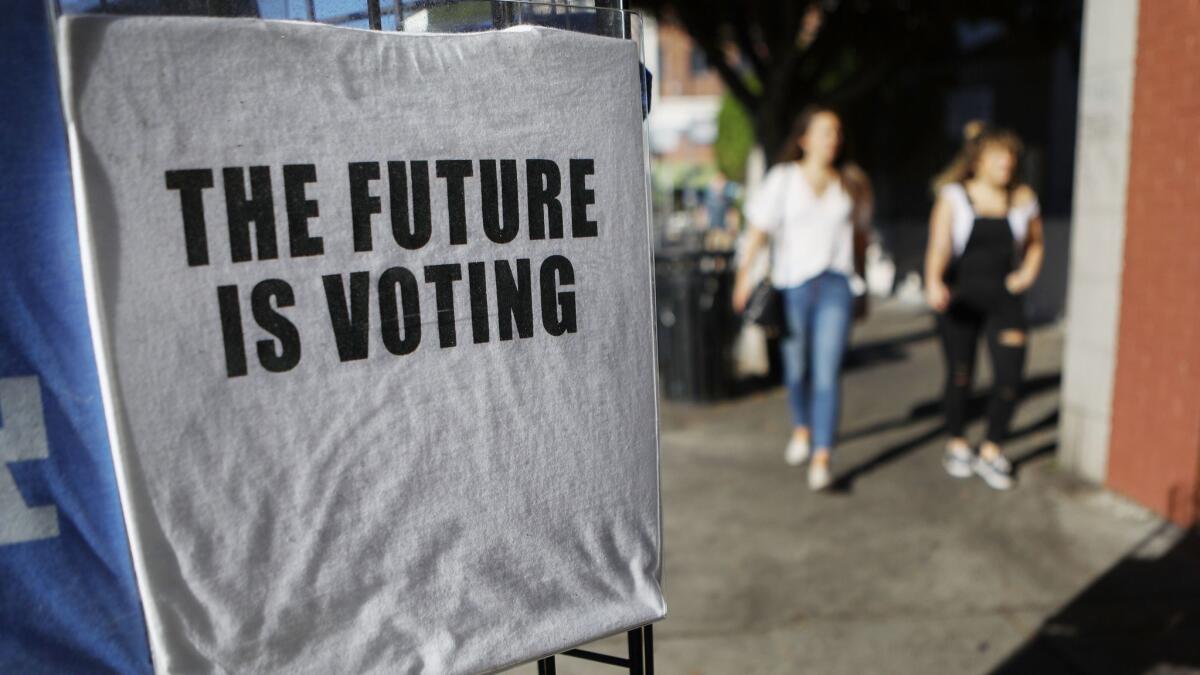Capitol Journal: The ‘blue wave’ has already arrived in California. Latinos and young people must vote for it to get stronger

Reporting from Sacramento — In lawmaking, politicians listen to the people first. Yes, they really do. But people need to speak up to be heard. And too often they’re mute.
Then big money talks. That’s the most common influence on lawmaking because citizens usually aren’t pressing politicians and threatening their careers. Unless that happens, lawmakers automatically yield to labor unions or oil companies or any interest that’s a friendly bankroller at election time.
Citizens have an opportunity to speak up Tuesday when U.S. House and legislative seats are filled on the California ballot, along with openings for the U.S. Senate, governor and other statewide offices.
For added oomph to their voices, voters should follow up by constantly badgering the politicians after they take office.
People always possess the most potent political power — if they use it.
This came to mind last week as I called veteran political operatives to ask what they were looking for in the California elections.
There was skepticism about a spectacular “blue wave” of Democratic strength emerging in California. Anyway, how would it be detected? A blue wave rolled on shore a decade ago and has gotten steadily stronger.
“California doesn’t need a blue wave. It’s already underwater,” says Republican consultant Richard Temple.
For the wave to intensify, certain things must happen. First, Latinos finally need to vote in numbers closer to their population size. The so-called sleeping giant needs to wake up.
Latinos are 34% of the state’s adult population but account for only 21% of likely voters, according to the Public Policy Institute of California. Even worse, they amounted to just 14% of the June primary voters.
A solid majority of Latino likely voters, 60%, are registered as Democrats. The party badly needs them to cast ballots.
Why don’t they?
“It’s a matter of priorities,” Secretary of State Alex Padilla told me last year. “When you’re trying to put a roof over your head and food on the table, you’re not tuning into the political debate.”
But Latinos have to be hearing President Trump trying to rouse his voter base with anti-immigrant bellowing — attacking birthright citizenship and the “invasion” by asylum-seeking migrants from Central America. Last summer his administration was yanking children from their migrant mothers’ arms and separating them at the border. And that wall.
Coverage of California politics »
The state Legislature has spent the last two years trying to galvanize Latinos by attacking Trump’s immigration policies.
What else do Latinos require to coax them to vote?
“Trump gets them halfway there, but it’s going to take something more aspirational,” says Daniel Zingale, senior vice president of the California Endowment, which promotes expansion of affordable healthcare for poor people.
“Someone has to offer them a more positive stake in the future. I run into people who say, ‘Yeah, he’s terrible. He’s terrorizing my people. But give me something to vote for.’”
The implication is that California Democrats haven’t been offering positive, realistic ideas, only lambasting Trump, a valid gripe against the party heard around the country.
Zingale has worked for three governors and was a senior advisor to Gov. Arnold Schwarzenegger. For 10 years, he has been trying to inspire habitual nonvoters to cast ballots.
“The same groups that don’t vote — the poor, rural residents, immigrants, Latinos — get the worst health services,” Zingale says. “They have unclean water, toxic wastes, no clinics, no parks. They have more asthma and more diabetes and less insurance.
“If they don’t vote, they don’t have a voice. They’re on the short end, the last in line in Sacramento for resources. Two things influence that: political money and votes. Latinos are not big political givers like Chevron. Their only chance for a voice is their numbers. And they have not discovered that.”
As of Friday, a record number of mail ballots had been turned in from all kinds of voters. But it’s guesswork whether that means a heavy turnout.
Paul Mitchell, who heads Political Data Inc., says 3.2 million ballots had been recorded, surpassing the early vote numbers of the last midterm election in 2014. But 13 million ballots were mailed out this time, compared with 9 million four years ago. “So it’s too early to jump to huge conclusions,” he says.
Once again, Latinos have been voting in small numbers. Although they received 23% of the mail ballots, only 14% of all those returned were from Latinos entering the weekend.
Young adults were looking even more apathetic: They received 25% of the mail ballots and had returned just 10% of the total, Mitchell says. Their votes certainly will be needed to create a blue wave.
Among millennials — ages 22 to 37 — 51% are registered Democrats, according to PPIC. Nearly one-third are Latinos.
“Will the youth turnout be as bad as usual or will it increase?” government professor Jack Pitney of Claremont McKenna College asks rhetorically.
“I’m Irish, so I’m pessimistic. It’s something people hope for that never happens. It’s the ‘Great Pumpkin’ of electoral politics.”
The professor explains: “Younger people aren’t as engaged with civic life, they’re not paying taxes, they don’t have kids in school and they move a lot so they need to re-register.”
But everyone votes in one manner or another. Those who cast ballots are telling politicians that they care. Those who sit it out are saying they don’t — and the pols won’t care much about them either.
Follow @LATimesSkelton on Twitter
More to Read
Get the L.A. Times Politics newsletter
Deeply reported insights into legislation, politics and policy from Sacramento, Washington and beyond. In your inbox three times per week.
You may occasionally receive promotional content from the Los Angeles Times.











